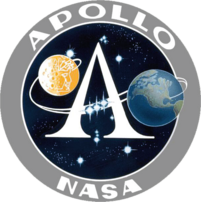Apollo 14
| Apollo 14 | |||||
Mission insignia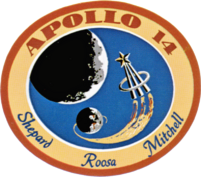 |
|||||
| Mission statistics[1] | |||||
|---|---|---|---|---|---|
| Mission name | Apollo 14 | ||||
| Command Module | CM-110 callsign Kitty Hawk mass 29,240 kg |
||||
| Service Module | SM-110 | ||||
| Lunar Module | LM-8 callsign Antares mass 15,264 kg |
||||
| Crew size | 3 | ||||
| Booster | Saturn V SA-509 | ||||
| Launch pad | LC 39A Kennedy Space Center Florida, USA |
||||
| Launch date | January 31, 1971 21:03:02 UTC |
||||
| Lunar landing February 5, 1971 09:18:11 UTC Fra Mauro 3° 38' 43.08" S 17° 28' 16.90" W (based on the IAU Mean Earth Polar Axis coordinate system) |
|||||
| Lunar EVA duration | First 04:47:50 Second 04:34:41 Total 09:22:31 |
||||
| Lunar surface time | 1 d 09 h 30 m 29 s | ||||
| Lunar sample mass | 42.28 kg (93.21 lb) | ||||
| Total CSM time in lunar orbit | 2 d 18 h 35 m 39 s | ||||
| Landing | February 9, 1971 21:05:00 UTC |
||||
| Mission duration | 9 d 00 h 01 m 58 s | ||||
Crew photo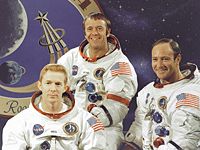 Left to right: Roosa, Shepard, Mitchell |
|||||
| Related missions | |||||
|
|||||
Apollo 14 was the eighth manned mission in the Apollo program and the third mission to land on the Moon, touching down on February 5, 1971.
Contents |
Crew
Number in parentheses indicates number of spaceflights by each individual prior to and including this mission.
- Alan B. Shepard, Jr (2) - Commander
- Stuart A. Roosa (1) - Command Module Pilot
- Edgar D. Mitchell (1) - Lunar Module Pilot
Backup crew
- Eugene A. Cernan - Commander
- Ronald E. Evans, Jr - Command Module Pilot
- Joseph H. Engle - Lunar Module Pilot
Support crew
- Philip K. Chapman
- Bruce McCandless, II
- William R. Pogue
- C. Gordon Fullerton
Flight directors
- Pete Frank, Orange team
- Glynn Lunney, Black team
- Milton Windler, Maroon team
- Gerry Griffin, Gold team
Mission parameters
- Mass: CSM 29,240 kg; LM 15,264 kg
- Perigee: 183.2 km
- Apogee: 188.9 km
- Inclination: 31.12°
- Period: 88.18 min
- Perilune: 108.2 km
- Apolune: 314.1 km
- Inclination: °
- Period: 120 min
- Landing Site: 3.64530° S - 17.47136° W or
3° 38' 43.08" S - 17° 28' 16.90" W
LM - CSM docking
- Undocked: February 5, 1971 - 04:50:43 UTC
- Docked: February 6, 1971 - 20:35:42 UTC
EVAs
EVA 1 start: February 5, 1971, 14:42:13 UTC
- Shepard - EVA 1
- Stepped onto moon: 14:54 UTC
- LM ingress: 19:22 UTC
- Mitchell - EVA 1
- Stepped onto moon: 14:58 UTC
- LM ingress: 19:18 UTC
- EVA 1 end: February 5, 19:30:50 UTC
- Duration: 4 hours, 47 minutes, 50 seconds
EVA 2 start: February 6, 1971, 08:11:15 UTC
- Shepard - EVA 2
- Stepped onto moon: 08:16 UTC
- LM ingress: 12:38 UTC
- Mitchell - EVA 2
- Stepped onto moon: 08:23 UTC
- LM ingress: 12:28 UTC
- EVA 2 end: February 6, 12:45:56 UTC
- Duration: 4 hours, 34 minutes, 41 seconds
Mission highlights

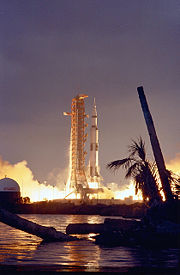


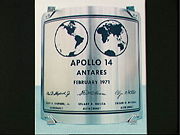
At the beginning of the mission, the CSM Kitty Hawk had difficulty achieving capture and docking with the LM Antares. Repeated attempts to dock went on for 1 hour and 42 minutes, until it was suggested that pilot Roosa hold Kitty Hawk against Antares using its thrusters, then the docking probe would be retracted out of the way, hopefully triggering the docking latches. This attempt was successful, and no further docking problems were encountered during the mission.
After separating from the command module in lunar orbit, the LM Antares also had two serious problems. First, the LM computer began getting an ABORT signal from a faulty switch. NASA believed that the computer might be getting erroneous readings like this if a tiny ball of soldering material had shaken loose and was floating between the switch and the contact, closing the circuit. The immediate solution—tapping on the panel next to the switch—did work briefly, but the circuit soon closed again. If the problem recurred after the descent engine fired, the computer would think the signal was real and would initiate an auto-abort, causing the Ascent Stage to separate from the Descent Stage and climb back into orbit. NASA and the software teams at MIT scrambled to find a solution, and determined the fix would involve reprogramming the computer to ignore the false signal. The software modifications were transmitted to the crew via voice communication, and Mitchell manually entered the changes (amounting to over 80 keystrokes on the LM computer pad) just in time.
A second problem occurred during the powered descent, when the LM radar altimeter failed to lock automatically onto the moon's surface, depriving the navigation computer of vital information on the vehicle altitude and groundspeed. This was later determined to be an unintended consequence of the software patch. After the astronauts cycled the landing radar breaker, the unit successfully acquired a signal near 50,000 feet, again just in the nick of time. Shepard then manually landed the LM closer to its intended target than any of the other five moon landing missions. Mitchell believes that Shepard would have continued with the landing attempt without the radar, using the LM inertial guidance system and visual cues. But a post-flight review of the descent data showed the inertial system alone would have been inadequate, and the astronauts probably would have been forced to abort the landing as they approached the surface.
After landing in the Fra Mauro formation - the destination for Apollo 13 - Shepard and Mitchell took two moon walks, adding new seismic studies to the by now familiar Apollo experiment package, and using a "lunar rickshaw" pull cart to carry their equipment. Roosa, meanwhile, took pictures from on board command module Kitty Hawk in lunar orbit.
The second moonwalk, or EVA, was intended to reach the rim of the 1,000 foot (300 m) wide Cone Crater. However, the two astronauts were not able to find the rim amid the rolling terrain of the crater's slopes. Later analysis, using the pictures that they took, determined that they had come within 65 feet of the crater's rim.
Shepard and Mitchell deployed and activated various scientific instruments and experiments and collected almost 100 pounds (45 kg) of lunar samples for return to earth. Other Apollo 14 achievements included: first use of Mobile Equipment Transporter (MET); largest payload placed in lunar orbit; longest distance traversed on the lunar surface; largest payload returned from the lunar surface; longest lunar surface stay time (33 hours); longest lunar surface EVA (9 hours and 17 minutes); first use of shortened lunar orbit rendezvous techniques; first use of color TV with new vidicon tube on lunar surface; and first extensive orbital science period conducted during CSM solo operations.
On the way back to Earth, the crew conducted the first U.S. materials processing experiments in space. The Apollo 14 astronauts were the last lunar explorers to be quarantined on their return from the Moon.
Shepard and Mitchell named their landing site Fra Mauro Base, and this designation is recognized by the International Astronomical Union (depicted in Latin on lunar maps as Statio Fra Mauro).
Mission notes
- Shepard is the only astronaut from Project Mercury (the original Mercury Seven astronauts) to reach the Moon. Another of the original seven, Gordon Cooper, had originally been scheduled to command the mission, but according to Chaikin, his casual attitude toward training, along with problems with NASA hierarchy (reaching all the way back to the Mercury-Atlas 9 flight) resulted in his relief.
- James McDivitt, the commander of Apollo 9, who would have been either the prime crew Lunar Module Pilot or the backup crew commander was unwilling to take a secondary role in the mission.
- Shepard brought a makeshift six iron golf club and two golf balls to the Moon, and took several swings (one-handed, due to the limited flexibility of the EVA suit). He exuberantly, and somewhat whimsically, exclaimed that the second ball went "miles and miles and miles" in the lunar gravity, but later estimated it actually went 200 to 400 yards (180 to 365 meters). Mitchell then used a lunar scoop handle as a javelin, creating the first 'Lunar Olympics'.
- Shepard's moonwalking suit was the first to incorporate red bands on the arms and legs and a red stripe on the top of the lunar EVA sunshade "hood", so as to allow easy identification of the commander while on the surface; on the Apollo 12 pictures, it had been almost impossible to distinguish between the two crewmen, causing a great deal of confusion. This feature was on Jim Lovell's Apollo 13 suit, but because of the accident, this was not used. It was used on the remaining three Apollo flights and is used on both the U.S. and Russian spacesuits on both the Space Shuttle and International Space Station.
- As of 2008, Mitchell is the only surviving member of the crew; Roosa died in 1994 from pancreatitis and Shepard in 1998 from leukemia.
- Roosa, who worked in forestry in his youth, took several hundred tree seeds on the flight. These were germinated after return to earth, and widely distributed around the world as commemorative Moon Trees.
- The mission was a personal triumph for Shepard, who had battled back from Ménière’s disease which grounded him from 1964 to 1968. He and his crew were originally scheduled to fly on Apollo 13, but in 1969 NASA Administrators switched the scheduled crews for Apollo 13 and 14. This was done to place the more experienced Apollo 8 veteran James Lovell in command of what would have been the first lunar landing attempt if both Apollo 11 and Apollo 12 had failed to successfully land.
- The crew got some good-natured razzing in the astronaut office as the first "all-rookie" Apollo crew (Shepard's 1961 flight on Freedom 7 was a suborbital flight). However, the problems they overcame with docking and landing tested them as much as any prior or subsequent Apollo crew.
Mission insignia
The oval insignia shows a gold NASA Astronaut Pin, given to U.S. astronauts upon completing their first space flight, traveling from the earth to the moon. A gold band around the edge includes the mission and astronaut names. The designer was Jean Beaulieu.
The backup crew spoofed the patch with its own version, with revised artwork showing the Road Runner cartoon character on the moon, holding a U.S. flag and a flag labeled "1st Team," as a gray-bearded (for Shepard, who was 47 at the time of the mission and the oldest man on the Moon), pot bellied (for Mitchell, who had a pudgy appearance), red furred (for Roosa's red hair) Wile E. Coyote flies in place of the astronaut pin. The flight name is replaced by "BEEP BEEP" and the backup crew's names are given. Several were left as "gotchas" on the Kitty Hawk.
Quotations
"And it's been a long way, but we're here."
Alan B. Shepard, Jr, his first words on the moon. Unlike Apollo 11's Neil Armstrong and Apollo 12's Pete Conrad, Shepard had already gotten off the ladder and was a few meters from the LM.
"Think you're finks."
Edgar B. Mitchell. (said in response to Cmdr. Shepard's suggestion to turn back during their second EVA, where they came within 65 feet (21 m) of the rim of the 1,000 foot (300 m) wide Cone Crater that they were looking for)
"Tell Cernan, BEEP-BEEP my ass!"
Al Shepard's response whenever one of the crew patches for the back-up crew would float out of a locker. Cernan, Evans and Engle had taken care to stash away patches in every single locker and compartment in the spacecraft.
Capsule location
The Apollo 14 Command Module Kitty Hawk is on display at the Astronaut Hall of Fame, Titusville, Florida.
The Lunar Module Antares impacted the Moon 07 February 1971 at 00:45:25.7 UT (06 February, 7:45 PM EST) 3.42 S, 19.67 W.
Media
Depiction in popular culture
Portions of the Apollo 14 mission are dramatized in the miniseries From the Earth to the Moon episode entitled "For Miles and Miles".
A fictional Apollo 14 lunar orbit mission was portrayed in the I Dream of Jeannie TV show episode entitled "Around the Moon in 80 Blinks".
See also
- Moon trees, taken from seeds brought to the Moon on Apollo 14.
- Extra-vehicular activity
- List of spacewalks
- Splashdown
- List of artificial objects on the Moon
- Google Moon
Notes
- ↑ Richard W. Orloff. "Apollo by the Numbers: A Statistical Reference (SP-4029)". NASA.
References
- NASA NSSDC Master Catalog
- APOLLO BY THE NUMBERS: A Statistical Reference by Richard W. Orloff (NASA)
- The Apollo Spacecraft: A Chronology
- Apollo Program Summary Report
- Apollo 14 Lunar Launch Video
- Apollo 14 Characteristics - SP-4012 NASA HISTORICAL DATA BOOK
- Lattimer, Dick (1985). 'All We Did was Fly to the Moon. Whispering Eagle Press. ISBN 0-9611228-0-3.
- NASA Manned Spacecraft Center (1971), 'Apollo 14 Technical Air-To-Ground Voice Transcription'
External links
- Apollo Lunar Surface VR Panoramas QTVR panoramas
- Map of surface activities for Apollo 14
- Apollo 14 entry in Encyclopedia Astronautica
- Apollo 14 Science Experiments
|
|||||||
